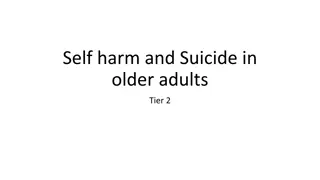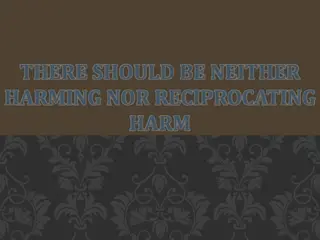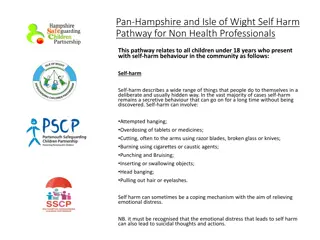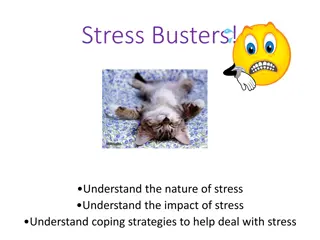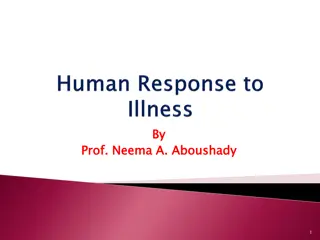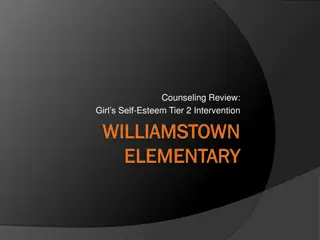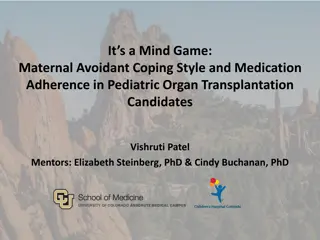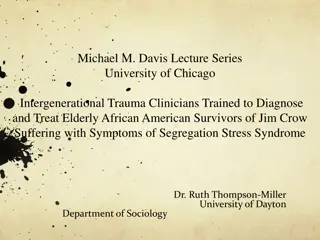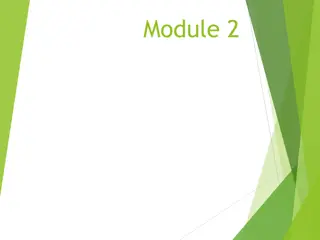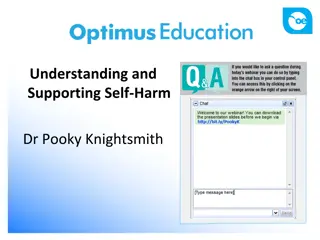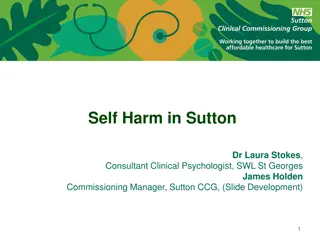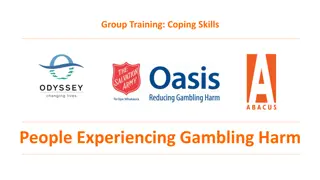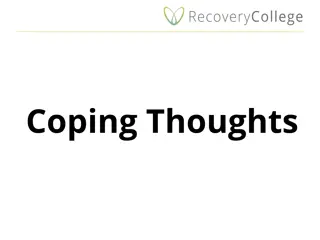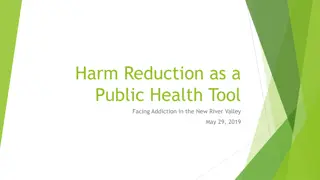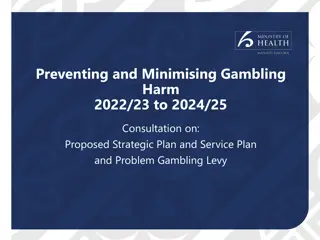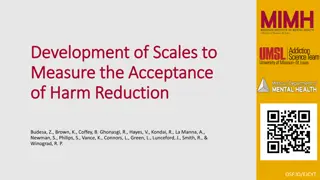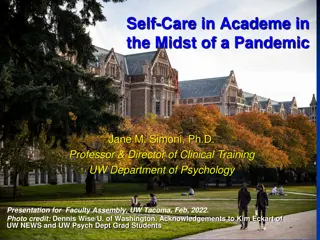Understanding Self Harm: Exploring the Impact and Coping Strategies
Self-harm, a complex behavior not limited to mental illness, is a way individuals cope with distress. The behavior ranges from smoking to life-threatening actions like overdosing. It affects a significant number of young people, with a notable increase in treatment for deliberate self-harm cases. Despite this, the true extent remains unknown, as many do not seek help. Coping mechanisms and support are crucial in addressing this concerning issue.
Download Presentation

Please find below an Image/Link to download the presentation.
The content on the website is provided AS IS for your information and personal use only. It may not be sold, licensed, or shared on other websites without obtaining consent from the author. Download presentation by click this link. If you encounter any issues during the download, it is possible that the publisher has removed the file from their server.
E N D
Presentation Transcript
Understanding Self Harm Gloucestershire Self Harm Helpline Alice Brixey
What is Self Harm? In pairs, discuss what you feel self harm is www.rethink.org
What is Self Harm? Self harm Unprotected Sex Drugs Self Injury Eating Alcohol Self harm is an umbrella term for behaviours that can cause injury or danger to oneself. www.rethink.org
What is Self Harm? There sno single definition of self harm - Self injury is when somebody intentionally damages or injures their body - Tissue damage to relieve tension Self harm is a behaviour it is not a mental illness. However, it could be a symptom of mental illness It is a sign of extreme distress - An internal scream Self harm is a way of coping with emotional pain, distressing memories, or overwhelming situations and experiences. www.rethink.org
What is Self Harm? After a difficult day, how do you cope? www.rethink.org
What is Self Harm? Self harm is a spectrum Smoking Alcohol Over-Exercising Eating Life-threatening behaviours, e.g. overdosing www.rethink.org
How Does Self Harm Affect You? The number of children (aged 10-14) who had been treated after deliberate self harm increased by 70% in the past two years. The number of teenagers (aged 15-19) treated increased by 23% in this period. Health and Social Care Information Centre, 2014 www.rethink.org
How Does Self Harm Affect You? 1 in 12 young people have self harmed Inpatient admissions due to young people self-harming increased by 68 per cent in the last 10 years. Last year, 38,000 young people were admitted to hospital because of their injuries. Young Minds www.rethink.org
What is the True Extent of Self Harm? The number of people who have self harmed but not sought help.... ? We don t know the true extent of self harm, as some people don t have/seek the support www.rethink.org
How Does Self Harm Affect You? Self-harm is the number one issue that young people are concerned about among their peers in a list including gangs, bullying, drug use and binge drinking. Self-harm is the one issue that all groups (young people, parents and professionals) feel least comfortable approaching with young people. Teachers feel helpless and unsure about what to say to a young person who is self-harming. There is little open communication about self harm www.rethink.org Talking Self Harm, Cello Group
Self Harm Facts MYTH 2. People who self harm have a suicide attempt require stitches or MYTH MYTH 4. Self harm is a failed 3. If self harm does not MYTH 1. People who self harm are just attention seeking personality disorder hospital treatment, then it is not serious Fact:Self harm is a behaviour, not an illness, though self harm can manifest as intense emotional distress an individual keeping oneself alive. Fact:Self harm is often a very private thing, and people can go to great lengths to cover it up. a part of a mental illness. feels. All self harm should be taken seriously Fact:Injuries rarely equate to the Fact:Self harm is often a way of www.rethink.org
Why Do Young People Self Harm? Family Factors: Individual Factors: Unreasonable expectations Neglect/ Abuse Poor relationships Mental Health Issues Low Self-Esteem Impulsivity Social Factors: Difficulty making relationships Bullying/ peer rejection Other Factors: Trauma Relationship Breakups Pressure/ Change Everyone has their own reasons for self harming www.rethink.org
The Self Harm Cycle Negative Emotions (Sadness, Anger, Despair) Why have you been so selfish? You re always trying to get attention. Tension (Inability to control emotions, maybe using disassociation to cope) You ve had everything given you your whole life, what s wrong with you? Self-Harm How could you do this to me? Cutting, Burning, Etc. Positive Effects (Endorphins released, tension and negative feelings dispelled for a short period of time) What have you done, you silly girl? Mum cries when I try to talk to her Negative Effects (Shame, guilt over self-harm act) www.rethink.org
The Self Harm Cycle Self Punishment Negative Emotions (Sadness, Anger, Despair) Distraction from problems Care eliciting Tension (Inability to control emotions, maybe using disassociation to cope) Reduction in tension Ways to communicate inner pain Self-Harm Cutting, Burning, Etc. Taking control Positive Effects (Endorphins released, tension and negative feelings dispelled for a short period of time) Outlet for anger Form of escape Negative Effects (Shame, guilt over self-harm act) Peer Group www.rethink.org
Functions of Self Harm Self Loathing Sacrifice Release Coping Distraction Self Harm Communication Calming Self-Punishment Control Coming back to Reality Self-Care Numbing Cleansing www.rethink.org
Means of Self Harming Type Means Cutting Most common method use any sharp object (i.e. razor/ scissors) Burning Flame/hot water/cigarette/bleach Using prescription medication or non-prescribed medication, or by ingesting liquids such as shampoo/bleach Overdosing From hair from eyebrows, eye lashes, scalp, arms, legs, pubic regions, often with tweezers or hands Hairpulling Scratching With brillo pads, nail brush, hands, etc Skin Picking Re-opening wounds/picking at imperfections Bone Breaking Causing damage to bones by using a hammer/other Restriction Using ligatures/ropes to restrict the flow of blood Insertion of Objects Inserting/swallowing razors Excessive Excessive use of alcohol &drugs, binge or restrictive eating. www.rethink.org
Practical Support www.rethink.org
Signs someone may be self harming Physical injuries that are observed more than once, and that appear too ordered to be accidental Disappearing at emotional times Loose/ baggy clothes Isolation, not wanting to engage Low mood, negative self-talk www.rethink.org No Harm Done, Young Minds
The First Conversation You may feel angry, shocked, not know what to do, upset... It can be difficult to find out someone is self harming These reactions are normal All evidence suggests having somebody to talk to is the most important aspect of recovery www.rethink.org
The First Conversation Don t judge or make assumptions Listen properly Don t blame them Show you care Don t just tell them to stop Stay calm Reassure them Take it seriously Be Supportive & Empathic Recognise it is a way of coping www.rethink.org
How to Help Know your Safeguarding Policies Encourage a young person to seek medical support, e.g. from a GP, NHS Direct Know relevant services and agencies Don t promise to keep a secret know confidentiality policies Make sure you get support too www.rethink.org
How to Help - Them Signpost to organisations, give information/ factsheets Explore Coping Strategies Take time to listen to them Remember, not all websites are appropriate Be Treat them normally comfortable exploring reasons why www.rethink.org
Coping Strategies Coping strategies are used to manage immediate distress they do not allow somebody to deal with the underlying issues Asking somebody to stop self harming without finding alternative ways of coping can be very detrimental Coping strategies work best when matched to the function of somebody s self harm www.rethink.org
Coping Strategies Function Coping Strategies Creativity, Writing, Talking, Exercise, Expressing emotions. Release Time limit, Rewarding yourself for not harming. Control Self Punishment Mimicking Self harm Expression of Emotions Calling help lines, Creativity, Talking, Positive thinking, socialising. Means of Staying Alive Making yourself safe, Mimicking self harm. Memory box, Medication/MH teams. Dissociation Self Loathing Be kind to oneself, Mimicking self harm. Grounding Mindfulness, Breathing, Relaxation. Be kind to oneself, Reasoning with yourself, Positive Thinking. Self Care www.rethink.org
Coping Strategies Self Release Control Punishment Setting a time limit Hitting a pillow. Bite into a chilli These methods won t work for everyone, it is trial and error. www.rethink.org
How to help if theyre not ready Is there someone else who may be able to have this conversation? Think of the young person and their support An informal environment or activity can help conversation flow Think about alternative ways of talking (e.g. text, helplines, etc) www.rethink.org No Harm Done, Young Minds
Gloucestershire Self Harm Helpline We aim to improve the lives of people affected by self harm, including friends, family, carers or professionals supporting the person self harming. Provide emotional support, a non- judgemental space to share, and signposting for users. To provide confidential support to people in Gloucestershire who self harm The helpline is open 7 days a week, 365 days a year. Offers a phone, text and web chat. Provide a service that empowers those that use it, and reduces stigma Use a Recovery-oriented approach, enabling people to build a meaningful quality of life (as defined by themselves). Reduce, and prevent, callers self harming behaviour and intent to self harm www.rethink.org
Every night, 5-10pm Call 0808 801 0606 Text 07537 410 022
Questions? Gloucestershire Self-Harm Helpline Alice Brixey









